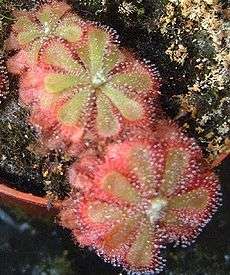Drosera aliciae
| Drosera aliciae | |
|---|---|
 | |
| Scientific classification | |
| Kingdom: | Plantae |
| (unranked): | Angiosperms |
| (unranked): | Eudicots |
| (unranked): | Core eudicots |
| Order: | Caryophyllales |
| Family: | Droseraceae |
| Genus: | Drosera |
| Species: | D. aliciae |
| Binomial name | |
| Drosera aliciae Raym.-Hamet | |
| Synonyms | |
| |
Drosera aliciae, the Alice sundew, is a carnivorous plant in the family Droseraceae. It is native to the Cape Provinces of South Africa,[1] like Drosera capensis, the cape sundew, and is one of the most common sundews in cultivation. The plant forms small, tight rosettes of wedge-shaped leaves, up to 5 cm in diameter. Under conditions of good lighting, the insect-snagging tentacles will become deeply coloured with anthocyanin pigments, which probably aid in its attraction of insect prey. The plant is relatively easy to grow, and produces attractive scapes of pink flowers, which are held about 30 cm away from the carnivorous leaves, so as to prevent pollinators from becoming ensnared. D. aliciae is very similar in form to a number of other closely related species such as D. slackii, and D. dielsiana: the former is rather larger (8 cm diameter); the latter rather smaller (3 cm diameter).
 Detail of leaf
Detail of leaf Flower
Flower
References
- ↑ "Drosera aliciae", World Checklist of Selected Plant Families, Royal Botanic Gardens, Kew, retrieved 2015-08-11
| Wikimedia Commons has media related to Drosera aliciae. |